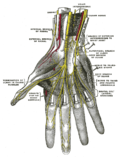Anterior interosseous nerve
Anterior Interosseous Nerve
The anterior interosseous nerve (AIN) is a motor branch of the median nerve that is primarily responsible for the innervation of several muscles in the forearm. It originates in the upper forearm, just below the elbow, and extends down to the wrist. The AIN is crucial for the functionality of the forearm and hand, particularly in movements involving the flexion of the thumb and index finger.
Anatomy[edit]
The anterior interosseous nerve branches off from the median nerve approximately 5 to 8 cm distal to the lateral epicondyle of the humerus. It descends along the interosseous membrane of the forearm, lying between the flexor digitorum profundus and the flexor pollicis longus muscles, which it innervates. Additionally, it supplies the pronator quadratus muscle, a deep muscle of the forearm that plays a significant role in the pronation of the forearm.
Function[edit]
The primary function of the anterior interosseous nerve is to innervate the flexor pollicis longus, the radial half of the flexor digitorum profundus, and the pronator quadratus. These muscles are essential for the flexion of the thumb and index finger, as well as the pronation of the forearm. The AIN does not have any sensory fibers; therefore, it does not contribute to the sensation in the hand or forearm.
Clinical Significance[edit]
- Anterior Interosseous Nerve Syndrome
Anterior interosseous nerve syndrome (AINS) is a condition characterized by weakness or paralysis of the muscles innervated by the AIN. Patients with AINS may have difficulty performing the "pinch" gesture, where the thumb and index finger are brought together. This condition can result from trauma, compression of the nerve, or idiopathic causes.
- Diagnosis and Treatment
Diagnosis of AINS involves clinical examination and may be supported by electromyography (EMG) and nerve conduction studies. Treatment typically focuses on relieving the compression of the nerve, which may involve physical therapy, anti-inflammatory medications, or surgical intervention in severe cases.
See Also[edit]

This article is a neuroscience stub. You can help WikiMD by expanding it!
-
Anterior interosseous nerve
-
Anterior interosseous nerve
-
Anterior interosseous nerve
Ad. Transform your life with W8MD's Budget GLP-1 injections from $75


W8MD offers a medical weight loss program to lose weight in Philadelphia. Our physician-supervised medical weight loss provides:
- Weight loss injections in NYC (generic and brand names):
- Zepbound / Mounjaro, Wegovy / Ozempic, Saxenda
- Most insurances accepted or discounted self-pay rates. We will obtain insurance prior authorizations if needed.
- Generic GLP1 weight loss injections from $75 for the starting dose.
- Also offer prescription weight loss medications including Phentermine, Qsymia, Diethylpropion, Contrave etc.
NYC weight loss doctor appointmentsNYC weight loss doctor appointments
Start your NYC weight loss journey today at our NYC medical weight loss and Philadelphia medical weight loss clinics.
- Call 718-946-5500 to lose weight in NYC or for medical weight loss in Philadelphia 215-676-2334.
- Tags:NYC medical weight loss, Philadelphia lose weight Zepbound NYC, Budget GLP1 weight loss injections, Wegovy Philadelphia, Wegovy NYC, Philadelphia medical weight loss, Brookly weight loss and Wegovy NYC
|
WikiMD's Wellness Encyclopedia |
| Let Food Be Thy Medicine Medicine Thy Food - Hippocrates |
Medical Disclaimer: WikiMD is not a substitute for professional medical advice. The information on WikiMD is provided as an information resource only, may be incorrect, outdated or misleading, and is not to be used or relied on for any diagnostic or treatment purposes. Please consult your health care provider before making any healthcare decisions or for guidance about a specific medical condition. WikiMD expressly disclaims responsibility, and shall have no liability, for any damages, loss, injury, or liability whatsoever suffered as a result of your reliance on the information contained in this site. By visiting this site you agree to the foregoing terms and conditions, which may from time to time be changed or supplemented by WikiMD. If you do not agree to the foregoing terms and conditions, you should not enter or use this site. See full disclaimer.
Credits:Most images are courtesy of Wikimedia commons, and templates, categories Wikipedia, licensed under CC BY SA or similar.
Translate this page: - East Asian
中文,
日本,
한국어,
South Asian
हिन्दी,
தமிழ்,
తెలుగు,
Urdu,
ಕನ್ನಡ,
Southeast Asian
Indonesian,
Vietnamese,
Thai,
မြန်မာဘာသာ,
বাংলা
European
español,
Deutsch,
français,
Greek,
português do Brasil,
polski,
română,
русский,
Nederlands,
norsk,
svenska,
suomi,
Italian
Middle Eastern & African
عربى,
Turkish,
Persian,
Hebrew,
Afrikaans,
isiZulu,
Kiswahili,
Other
Bulgarian,
Hungarian,
Czech,
Swedish,
മലയാളം,
मराठी,
ਪੰਜਾਬੀ,
ગુજરાતી,
Portuguese,
Ukrainian


